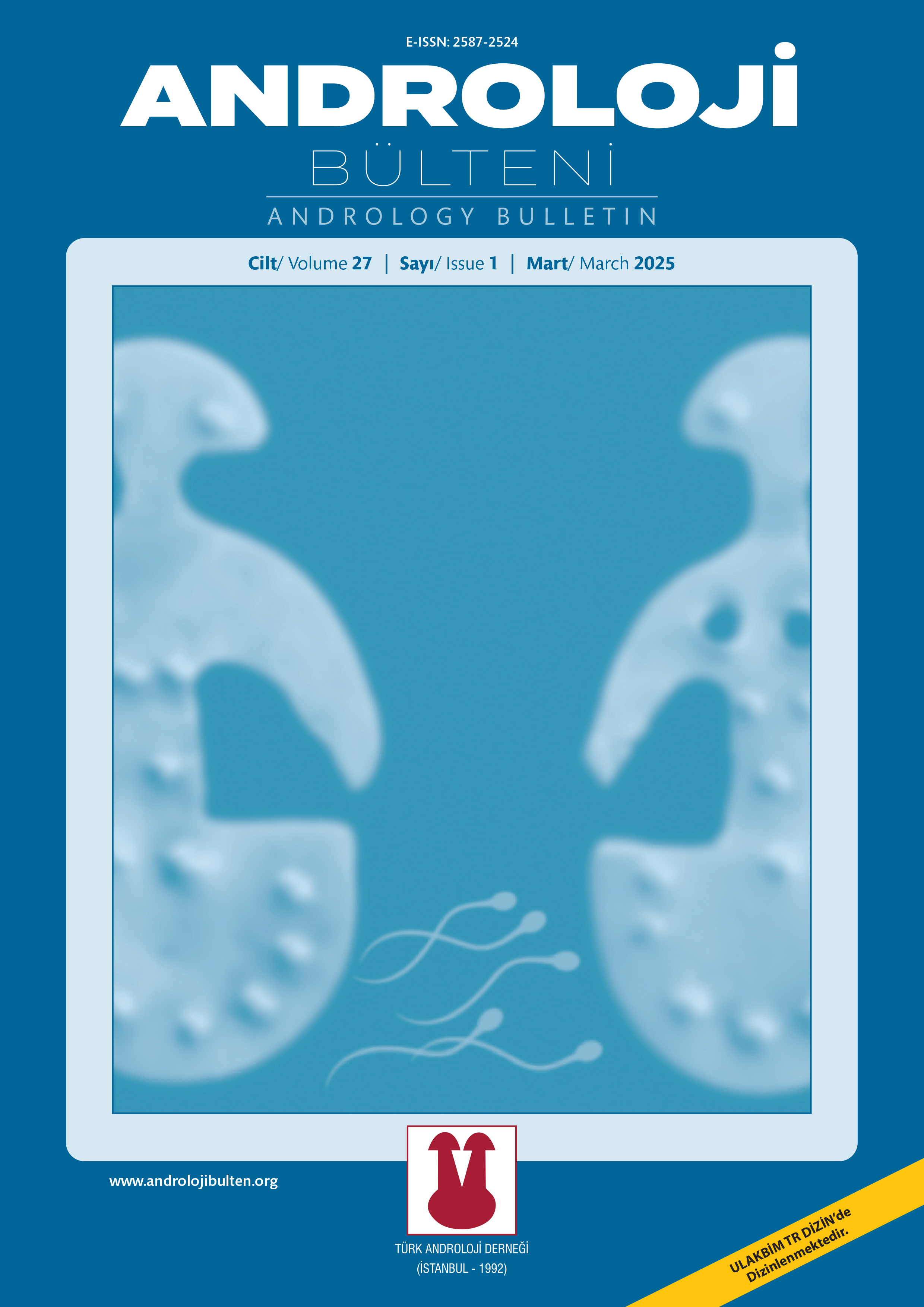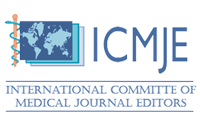INDEXES

Content of this journal is licensed under a Creative Commons Attribution-NonCommercial 4.0 International License.
Volume: 26 Issue: 1 - 2024
| 1. | Cover Page I |
| 2. | Reviewers Pages II - III |
| 3. | From the President Page IV |
| 4. | From the Editor Page V |
| 5. | Contents Page VI |
| ORIGINAL ARTICLE | |
| 6. | Nursing students’ attitudes towards sexual health Nedime Gül Doğan Özdemir, Cansu Karadeniz Benli, Atife Çetin doi: 10.24898/tandro.2024.37108 Pages 1 - 7 OBJECTIVE: The purpose of this research is to evaluate nursing students’ attitudes towards sexual health. MATRERIAL and METHODS: This research; It was conducted in descriptive and cross-sectional type. The research was conducted at the Faculty of Health Sciences of a state university located in the Black Sea region. Data were collected in the working environment through face-to-face interviews. Personal Information Form and Students’ Attitudes Towards Sexual Health Scale were used to collect research data. The data were evaluated in the IBM Statistical Package for Social Sciences (SPSS) program version 24.0 statistical program. Descriptive statistics are given as number of units (n), percentage (%), mean and standard deviation (X̄ ± SD), median (min-max) values. RESULTS: There is a statistically significant relationship between nursing students’ grade level, where they live, whether they receive training on sexual health care, how often they evaluate their sexual health while providing care, and how they feel when providing sexual health care. The students’ “Attitudes Towards Sexual Health Scale” total score average was found to be 44.83±10.45. This result indicates that students have positive attitudes towards sexual health behaviors. CONCLUSION: As a result, when students’ scores from the Attitudes Towards Sexual Health Scale are examined, their level of training in sexual health care, their frequency of evaluating sexual health while providing care, and their feeling of self while providing sexual health care positively affect the process of evaluating sexual health in their future patients. |
| 7. | Relationship between sexual myth and sexual attitudes in Turkish women and associated factors: A correlational study Sıla Gül, Şahika Şimşek Çetinkaya doi: 10.24898/tandro.2024.87059 Pages 8 - 15 OBJECTIVE: Sexual myths are exaggerated, false, and unscientific beliefs and thoughts about sexuality. Sexual myths are generally more prevalent in conservative societies. Sexual myths can affect our attitude towards sexuality. This study was conducted to determine the relationship and related factors between sexual myths and sexual attitudes among women in Türkiye. MATRERIAL and METHODS: This research is a relational and descriptive study. The study was conducted with 150 women who applied to the obstetrics and gynecology outpatient clinics in Türkiye between May and July 2022. Data were collected using a personal information form, the Sexual Myth Scale (SMS), and the Brief Sexual Attitude Scale (BSAS). The data were analyzed with IBM Statistical Package for Social Sciences (SPSS) for Windows program version 22. Numbers, percentages, minimum and maximum values, averages, standard deviations, and some statistical analyses were used to analyze the data. RESULTS: Participants scored 73.90±17.56 points on the SMS and 80.58±7.59 points on the Hendrick Sexual Attitudes Scale. According to the participants’ sociodemographic characteristics, the difference between the mean total scores of the SMS was statistically significant (p<0.05). Still, the difference between the mean total scores of the Hendrick Sexual Attitude Scale was not statistically significant (p>0.05). There was no statistically significant relationship between the SMS and the Hendrick Sexual Attitude Scale (p<0.05). CONCLUSION: Increasing women’s knowledge about sexuality and providing continuous education on this subject will help to reduce sexual myths. It is important to address sexual attitudes separately to develop positive sexual attitudes in women. |
| 8. | Sexual dysfunction and associated factors in menopausal women: A correlational study Ekin Dila Topaloğlu Ören, Gül Ertem doi: 10.24898/tandro.2024.62681 Pages 16 - 27 OBJECTIVE: This study aimed to determine the risk of sexual dysfunctions in menopausal women and to detect the associated factors of sexual dysfunctions of women in western Türkiye. MATRERIAL and METHODS: This descriptive and correlational study was conducted with 304 menopausal women who came to the gynecology policlinic of a training and research hospital in Izmir, western Türkiye, between June 2019 and February 2020. Data were collected using the “Descriptive Information Form”, and “ Female Sexual Function Index (FSFI)”. RESULTS: More than half (258/84.9%) of the menopausal women were at risk of sexual dysfunction with lower scores in the domains of sexual desire, arousal, and satisfaction. Results showed that duration of menopause (ORad 1.34; 95% CI 1.07–1.68) and women under high school (ORad 2.67; 95% CI 1.07–6.70) and those who were obese (ORad 15.09; 95% CI 3.27–69.66) and those who gave vaginal delivery (ORad 2.91; 95% CI 1.11–7.62) was significantly associated with sexual dysfunction. CONCLUSION: Sexual dysfunction was reported with a high prevalence in menopausal women. Sexual function was negatively affected by increased duration of menopause, low education level, obesity, and vaginal delivery. Health professionals (especially gynecologists and gynecology nurses) should provide education and counseling to women regarding the sexual dysfunctions experienced by menopausal women and the associated factors. |
| 9. | Effect of double J stent on female sexual functions after ureterorenoscopy Gökhan Çil, Mehmet Yılmaz, Yusuf Şahin, İbrahim Oğulcan Canıtez, Muhammet Murat Dinçer doi: 10.24898/tandro.2024.65391 Pages 28 - 32 OBJECTIVE: This study aims to evaluate the impact of double J stenting on female sexual functions following ureterorenoscopy (URS). MATRERIAL and METHODS: Between April 2023 and September 2023, data from a total of 60 patients who underwent ureteroscopy (URS) treatment for ureteral stones in our clinic and a control group consisting of 30 individuals were retrospectively analyzed. Demographic and clinical characteristics of the patients, including age, body mass index (BMI), stone size, whether a double J stent was placed or not, length of hospital stay, duration of the double J stent in the patient, patients’ educational status, and Female Sexual Function Index (FSFI) scores at preoperative, postoperative 1 st, and 3rd months, were recorded. To assess psychological status, Beck Depression Scale scores were recorded at preoperative, postoperative 1 st, and 3rd months. The obtained parameters were compared between the groups. RESULTS: There were no statistically significant difference in mean age and BMI among the three groups (p=0.877 and p=0.932, respectively). The preoperative FSFI scores for Group 1, Group 2, and Group 3 were 13.83±1.76, 13.51±1.45, and 15.72±1.36, respectively. A statistically significant difference was observed among the groups (p<0.001). The FSFI scores at postoperative 1st month were 14.2±1.39 for Group 1 and 12.82±1.5 for Group 2, with a statistically significant difference between the groups (p<0.001). The FSFI scores at postoperative 3rd month were 14.54±1.7 for Group 1 and 14.4±1.54 for Group 2 (p=0.740). There was no statistically significant difference in Beck Depression scores during the preoperative period among the three groups (p=0.966). CONCLUSION: Based on our study, we believe that the placement of a double J stent after ureteroscopy (URS) may lead to a temporary impairment in female sexual functions. We recommend that patients be informed about this aspect during the preoperative period, suggest the removal of the double J stent at the earliest possible time when deemed necessary. |
| 10. | Evaluation of semen analysis standardization in andrology laboratories accordingto the criteria of World Health Organization (WHO) Muhamet Afşin, Mesude Duman doi: 10.24898/tandro.2024.63625 Pages 33 - 40 OBJECTIVE: Due to its complexity and subjectivity, semen analysis is difficult to standardize across laboratories. Our aim in this study is to collect basic information about semen analysis of andrology laboratories in Türkiye and to determine the level of standardization within and between laboratories for semen analysis. MATRERIAL and METHODS: A survey consisting of 41 questions covering all aspects of semen analysis was sent to 145 andrology laboratories that perform semen analysis in Türkiye. Of all, 106 laboratories filled out and returned the survey. The content of the survey was prepared according to the procedures specified in the 6th edition of the 2021 World Health Organization (WHO) laboratory handbook for the examination and processing of human semen. The survey was designed to obtain information about the reported parameters, semen collection and storage, macroscopic-microscopic evaluation, advanced tests and internal-external quality control of the laboratory. RESULTS: In relation to the laboratories, 84.1% of the parameters reported in semen analysis, 75.8% of the semen collection phase, 76.5% of the storage of semen in the laboratory and macroscopic analysis, 78.07% of the microscopic analysis of semen, 49.8% of advanced tests and 73% of the parameters related to quality criteria were compatible with WHO 2021 criteria. CONCLUSION: There appear to be differences between laboratories in Türkiye in the reporting and standardization of semen analysis according to the WHO 2021 criteria. Many different standards and criteria are used for semen analysis in andrology laboratories. This makes it difficult to compare results from one laboratory to another. Therefore, it should be recommended that semen analysis be evaluated according to the criteria set by international standards and guidelines. |
| REVIEW | |
| 11. | Interventions for postpartum sexual dysfunction problems: A systematic review of randomized controlled studies Hilal Gül Boyraz, Nülüfer Erbil doi: 10.24898/tandro.2024.00087 Pages 41 - 49 OBJECTIVES: The purpose of this systematic review is to conduct a systematic review of interventions for postpartum sexual function problems. MATERIAL and METHODS: In this systematic review, “PubMed”, “Cochrane”, “Web of Science”, “Science Direct” and “Scopus” databases were searched with the keyword “interventions AND postpartum sexual dysfunction”. The systematic review aimed to include studies published in the last five years, published in English or Turkish, with full text available, and containing interventions for postpartum sexual dysfunction. The Preferred Reporting Items for Systematic Reviews and Meta-Analyses (PRISMA) guideline was used for study design. The methodological quality of the studies included in the systematic review was evaluated according to the “Joanna Briggs Institute Critical Appraisal Checklist for Randomized Controlled Studies” published by the Joanna Briggs Institute. RESULTS: Eight articles published between 2019–2022 were included in the synthesis phase of the systematic review. It was determined that the “Female Sexual Function Scale” was most commonly used in the studies included in the systematic review. Studies have shown that various interventions such as pelvic floor muscle exercise training, postpartum sexual health programs, and sensory focus technique have been implemented for sexual function problems. It has been determined that pelvic floor muscle exercises, sensory focus technique, pelvic floor muscle trainers, sexual counselling based on PLISSIT and BETTER models, and Postpartum Sexual Health Programs have positive effects on postpartum sexual dysfunctions, while intra-vaginal oxytocin application and far infrared radiation have no effect. CONCLUSION: It has been determined that interventions for postpartum period sexual dysfunctions generally have a positive effect on women’s sexual lives. In order to achieve improvements in postpartum sexual dysfunction, it is recommended to develop various interventions and evaluate them with different measurement tools in larger sample groups. |
| 12. | Andrological issues in aging men Veysel Sezgin, Caner Baran doi: 10.24898/tandro.2024.03789 Pages 50 - 56 Aging is an inevitable process that brings about biological, physiological, psychological, and social changes throughout every stage of human life, with no known possibility of reversal. This process affects an individual’s life from birth to death. Socioeconomic and medical advancements have significantly increased life expectancy worldwide. In our country, the average age rose from 28.3 years in 2007 to 33.5 years in 2022, indicating a clear trend toward an aging society. With the growing elderly population, the field of andrology encounters diseases and risks associated with aging with increasing frequency. Advancing age in men can lead to a decline in testosterone levels, which can cause various physical and mental changes. These changes can include decreased sexual desire, erection problems, and declining sperm quality. The purpose of this compilation is to summarize the effects of aging on andrological diseases in light of current scientific literature. |
| 13. | Current approach to non-obstructive azospermia Yusuf Arıkan, Mehmet Zeynel Keskin, Burak Karabacakoğlu doi: 10.24898/tandro.2024.88785 Pages 57 - 62 Infertility affects 1 in 6 couples and male factor infertility is the cause in 50% of cases. Azoospermia is defined as the absence of spermatozoa in the ejaculate and is considered the most extreme form of male factor infertility. In the past, these men were considered infertile, but with the advent of testicular sperm extraction and assisted reproductive technologies, men with azoospermia can biologically father their own children. Non-obstructive azoospermia (NOA) occurs when there is a defect in spermatogenesis. This review describes the contemporary management of NOA and discusses the role of hormone stimulation therapy, surgical and embryological factors, and new technologies such as proteomics, genomics and artificial intelligence systems in the diagnosis and treatment of men with NOA. We also emphasise that men with NOA represent a vulnerable population at high risk of developing cancer and cardiovascular comorbidities. |
| 14. | Perinatal testicular torsion Sibel Eryılmaz, Fatma Nur Aracıer Uçaner, Alparslan Kapısız, Cem Kaya, Ramazan Karabulut, Zafer Türkyılmaz, Ali Atan, Canan Türkyılmaz, Kaan Sönmez doi: 10.24898/tandro.2024.46667 Pages 63 - 66 Early detection of perinatal testicular torsion (PTT), early use of Doppler US, and a shorter decision-making process achieved with early involvement of pediatric surgery/urology may affect prognosis, especially in the postpartum PTT setting. Considering that 3% asynchronous bilateral PTT rates have been reported in the literature, early consultation and ultrasonography are recommended for early diagnosis in suspected cases. Frequent follow-up or orchiopexy should be performed to protect the contralateral testis, if necessary, in order to avoid anorchic situation in the future. |
| 15. | Metabolic syndrome and male infertility Arzu Ateş, Çağatay Özsoy, Ayça Tuzcu doi: 10.24898/tandro.2024.49002 Pages 67 - 74 Metabolic syndrome (MetS) represents a cluster of conditions that have a negative impact on human health overall. Its prevalence has been rapidly increasing worldwide and has coincided with a global decrease in birth rates and fertility potential. This review aims to address this observation through studying the relationship between MetS and male reproductive health. The effects of obesity, dyslipidemia, hypertension, and insulin resistance on male fertility were examined and supporting evidence explaining the pathophysiology of sperm dysfunction with each MetS component were described. Adopting a healthy lifestyle appears to be the single most important intervention to prevent the unwanted effects of MetS on men’s health and fertility. Further studies addressing the components of MetS and their impact on male reproduction are required to enhance our understanding of the underlying pathophysiology and to propose new methods for therapeutic intervention |
| CASE REPORT | |
| 16. | Median raphe cyst extending from the scrotum to the perianal region: Case report Kenan Yalçın doi: 10.24898/tandro.2024.55822 Pages 75 - 77 Median raphe cysts are located anywhere between the external urethral canal and the anus. Cysts can occur in the parameatus, glans penis, penis shaft, scrotum, or perineum. The perianal region is a region where these lesions are extremely rare. In this article, we present a 2-year-old male patient who had a cystic lesion extending from the scrotum to the perianal region and was brought to our clinic by his family. The 5–6 cm cystic lesion was completely removed surgically. The histopathological diagnosis of the lesion was median raphe cyst. No recurrence was observed in the patient who was followed for 3 years. |
| PUBLICATIONS AND CONGRESS CALENDAR OF ANDROLOGY | |
| 17. | Publications and Congress Calendar of Andrology Pages 78 - 82 Abstract | |














